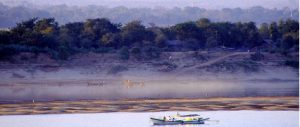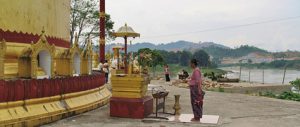Editor’s note: since the suspension of the multibillion dollar, China-backed Myitsone dam last autumn, Chinese investments in Myanmar have been in the spotlight. We’ve published a fair amount on this topic already, including a three-part history of Sino-Burmese relations by Tsinghua University professor Qin Hui and a translated analysis of the risks posed to Chinese investors by Myanmar’s political upheaval (from Bloomberg Businessweek‘s Chinese edition). The topic continues to generate a lot of column inches in the Chinese press. Here is a translation of an article from Guangzhou-based publication Time Weekly about fears for another investment, a twin pipeline project due to start pumping oil and gas to China next year.
In late February, Burmese vice-president U Tin Aung Mying Oo led a ministerial delegation to Maday Island on Myanmar’s west coast, the starting point for two major pipelines that will carry oil and gas to China from next year, should everything go to plan.
He heaped praised on the project, saying it would benefit the people of both nations. And he stressed that if gas and oil are to flow through the pipelines by the end of May 2013 as planned, then all sections of the project (in Burma, China and offshore) will have to be completed and connected in the near future.
This was the first high-level visit to the scheme – a joint venture between China’s state-owned China National Petroleum Corporation (CNPC) and Myanma Oil and Gas Enterprise (MOGE) – by Myanmar’s new government. The Chinese media hailed the event as a show of support for the project that indicates the confidence of both nations’ leaders in this collaborative effort.
But other factors at work in Myanmar may yet intervene to hold up the scheme. Since June 2011, the Burmese army has been fighting the Kachin Independence Army (KIA), an ethnic militia in the north of the country, in fierce clashes that could impact on the construction of the pipelines and leave CNPC caught in the crossfire.
On October 1, 2011, a ceremony was held in Myanmar’s Shan State to mark the start of work on the fourth section of the pipelines. Since then, a steady stream of machinery and pipeline parts have been arriving in Myanmar and the south Chinese province of Yunnan by road and rail. Materials are also stored along the route: anyone driving from Kunming to the Burmese border will pass enormous piles of waiting supplies.
The pipelines, expected to carry a final price tag of US$2.54 billion (16 billion yuan), begin in Kyaukpyu and enter China at the border town of Ruili in Yunnan province. Once they are up and running, an estimated 22 million tonnes of crude oil and 12 billion cubic metres of natural gas will flow into China every year.
The oil pipeline will run for 771 kilometres within Myanmar’s borders and then a further 1,631 kilometres through China. The natural gas pipeline will be slightly longer, at 793 kilometres in Myanmar and 1,727 kilometres north of the border. A refinery is also under construction in the city of Anning, Yunnan. All three projects are due for completion in 2013.
For the experienced Chinese firm leading the construction effort, it’s a straightforward engineering job – there are no major technical challenges. But civil society opposition poses a different set of problems.
In February 2012, workers completed a section of the pipeline at Mandalay’s Mount Popa Buddhist Reserve, part of the religious heritage of ancient Bagan and an area that enjoys the highest level of state protection due to its natural beauty. On the morning of February 15, a tunnel under the Irrawaddy River, the first of the pipeline’s tunnels, was successfully drilled.
But the good news announced on the website of the China Petroleum Pipeline Bureau was not received with universal applause. On March 1, about 100 Burmese citizens protested outside their country’s embassy in Thailand, calling for Myanmar’s president Thein Sein to halt the project.
“The benefits of the scheme aren’t being shared with the people,” complained one organiser with the Shwe Gas Movement. “The financing and responsibilities are opaque, and there is no corporate responsibility. We’re targeting all associated companies and interested parties, with simultaneous protests at the Burmese, Indian, Korean and Chinese embassies in Thailand.”
Jason Tower, an employee of Quaker NGO the American Friends Service Committee with a long-standing interest in Myanmar, explained that these organisations are made up of members of the 1988 Burmese democracy movement who fled to Thailand. They have long opposed the Burmese junta and anyone who works with it. “The construction company should look into the social impact of the project, make contact with Burmese civil society and strengthen dialogue,” he said.
The business environment in Myanmar remains uncertain. Three major projects have been halted in the last eight months: a Thai coal-fired power plant as well as China’s Myitsone dam and an Indian hydropower plant. The suspensions and uncertainties have called many other projects into question.
In addition, the handling of land requisitions and community resettlements has ramped up the tensions. Border residents near Ruili said that, 86 households impacted by the dam over the border at Namhkan, the northernmost town in Shan State, received no compensation until external pressure finally pushed the authorities to make partial payments.
Even though the families in question eventually received some money, and even though their affairs were handled by the Burmese side, not the Chinese parties, many of the locals still blame China: “the Chinese started work without paying anything” is a common refrain.
As a result, while Chinese firms have been doing their best to boost their image in the region – assisting flood victims, building schools for orphans and investing in local education, for instance – they do not have the full support of the Burmese people.
While vice-president U Tin Aung Mying Oo praised CNPC and other firms for their work in February, he also stressed the importance of public welfare. He expressed gratitude for the Chinese partner’s decision to use local labour for 70% of jobs, and also hopes for greater cooperation with Burmese firms in the construction and operation of the pipelines in order to provide even more jobs and allow the transfer of advanced technical and management skills.
Zhang Jialin, president of CNPC subsidiary South-East Asia Pipeline, said that firms involved in the construction project donated a total US$4.07 million in 2011 for the construction of 45 schools and 24 hospitals or clinics, improving healthcare for 800,000 people. In March 2011, the shareholders of the joint venture agreed to spend US$1 million annually on public welfare projects along the route of the pipeline.
But the tensions persist. “We heard a pipeline was going to be built back in 2005, and that it would run through KIA-held territory. Given our history with the government and the different interests involved, we were worried that there would be some conflict,” said a KIA liaison officer. “We informed the Chinese authorities that there would be problems building the pipeline if the political and economic issues were not resolved in advance.” There was never any response, he said.
The Burmese army and the KIA have been fighting on and off for decades. The last ceasefire was signed in 1994. But in June last year, the 17-year peace agreement was broken by the Burmese army when it attacked KIA territory to protect a Chinese-built dam on the Tarpein River. They said the KIA had ignored an order to withdraw from an area near the hydropower plant.On September 23, the army went on to attack a KIA area in Shan State, in order to allow construction of the pipeline.
“This Kachin area of Shan State has seen some of the worst fighting,” the liaison officer explained. The region is a patchwork of territories held by an array of different militias: the KIA’s 4th Brigade and their allies the Northern Shan Army and the Ta’ang Liberation Army, along with the “Old 4th Brigade”, which signed a peace deal with the government in January 1991. There are other, smaller militias too.
The Burmese army has not been particularly successful, taking only major roads and a few strategic points, and the KIA continues to fight a guerrilla war from the surrounding mountains. According to rumours coming out of Kachin-held parts of Shan State, the KIA may seek to take revenge by sabotaging the pipeline.
“That’s just a government-spread rumour, we’re not against the pipeline and nor will we attack it – on the contrary, we can protect it,” said Lanyaw Zawng Hra, president of the Kachin Independence Organisation and its international affairs chief, on the phone. “But one thing needs to be made clear – if the government army follows the pipeline into our territory, then the KIA will fight to the death, and other militias are bound to be caught up in the conflict. And that fighting may damage the pipeline.”
Zhao Lei [his Chinese name], governor of the south of the Kachin territory, said he hoped that China would intervene to end the crisis – that would help all three parties. “I hope China and the Burmese government can understand the ethnic sentiment here, and allow us room to live. We haven’t been fighting all this time for independence, just for a high degree of autonomy, for recognition and respect.”
He added that that pipeline will bring economic development for all ethnic groups in the area and improve the quality of life. That’s why the Kachin want to protect the pipeline and have no interest in damaging it, he said.
This article was first published in Time Weekly, where Yin Hongwei is a reporter. It is reproduced here with permission.
Photo by: anevillemorgan



